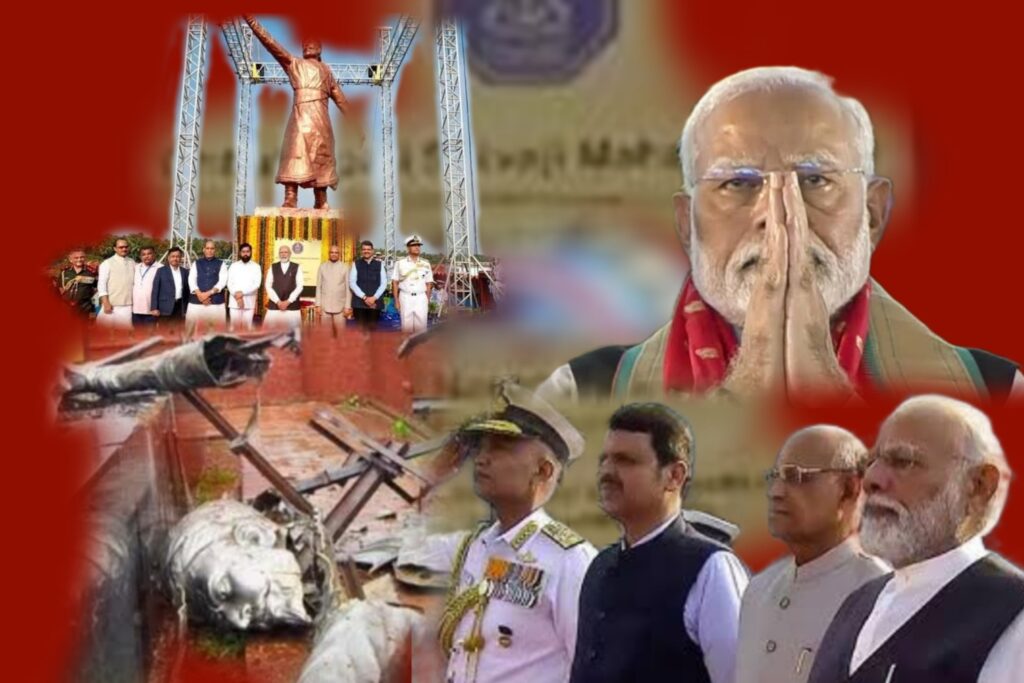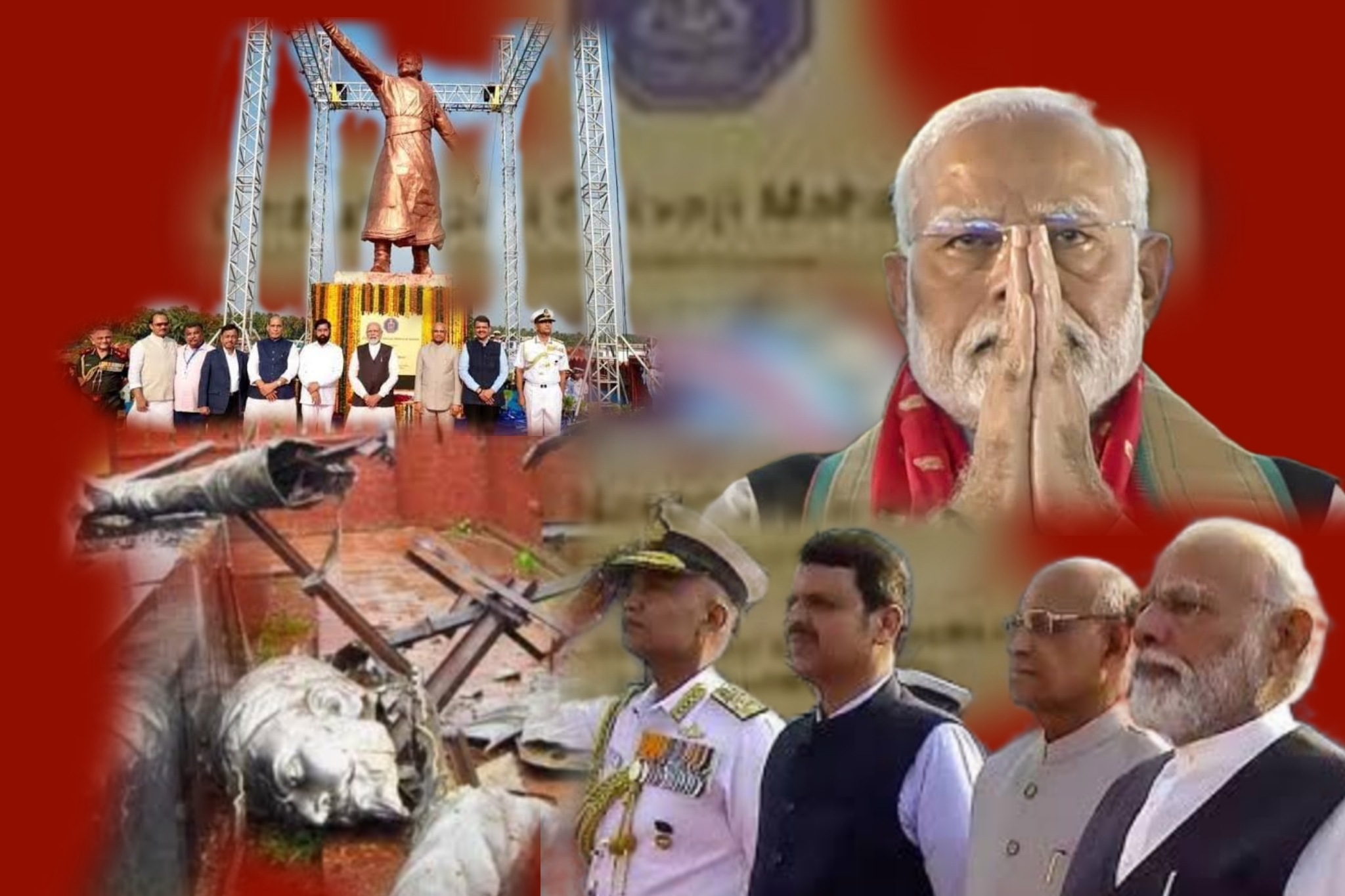
In an era proclaimed as “Amrit Kaal”—a time of supposed unprecedented progress and national resurgence—a scandal of shocking proportions has unfolded in Maharashtra. The collapse of Chhatrapati Shivaji Maharaj’s statue, a monument that cost the nation a staggering ₹3300 crores, just nine months after its construction, has sparked outrage across the country. This is not just an architectural failure but a glaring symbol of the deep-rooted corruption that continues to plague the Indian political and administrative landscape.
The Shivaji statue was intended to be a tribute to one of India’s most revered historical figures, a symbol of Maratha pride, and a beacon of India’s rich heritage. However, its untimely downfall has turned it into a metaphor for the systemic rot within our governance. The statue’s collapse is not just a technical failure; it represents the collapse of trust in those entrusted with public funds and responsibilities.
The ₹3300 Crore Scam: An Unforgivable Betrayal
Prime Minister Narendra Modi’s apology for this debacle has done little to assuage the anger of the citizens who rightfully feel betrayed. The misuse of ₹3300 crores—a colossal sum drawn from taxpayers across the nation—is not something that can be wiped away with a mere apology. This incident raises serious questions about the accountability of those in power and the lack of consequences for such blatant misuse of public money.
The statue’s collapse is not an isolated incident but part of a disturbing trend where infrastructure projects—bridges, complexes, and monuments—are crumbling across the country due to corruption, poor planning, and substandard execution. From the Mahakal complex in Ujjain to the overbridge in Varanasi, public works are increasingly becoming synonymous with corruption and inefficiency.
A Wider Problem of Corruption and Media Silence
What makes this situation even more egregious is the deafening silence from the mainstream media. The failure of the Shivaji statue should have sparked widespread investigative journalism and public discourse, but instead, it has been normalized, swept under the rug by a media landscape that appears more interested in serving the interests of those in power rather than holding them accountable.
The media, which should be the watchdog of democracy, is failing in its duty. This failure is exacerbated by the fact that when similar incidents happen under the watch of leaders from marginalized communities—Dalits, Backward Classes, and minorities—the media is quick to highlight and criticize. However, when corruption and negligence occur under the current government, the silence is deafening.
This selective outrage reveals the casteist and biased nature of much of our media. The media’s failure to hold the government accountable for the Shivaji statue scandal is a disservice not only to journalism but also to the democratic principles on which our nation is built.
The Role of the Judiciary and the Need for Accountability
The judiciary, too, has a crucial role to play in this crisis. The lack of suo motu action from the Supreme Court and High Courts in response to such blatant misuse of public funds is troubling. If the judiciary does not step in to correct such wrongs, it risks being seen as complicit in the erosion of the rule of law.
The collapse of the Shivaji statue, and the broader pattern of corruption it symbolizes, demands accountability at the highest levels of government. Whether it is the Prime Minister, Chief Ministers, or other high-ranking officials, those responsible must be held to account. This is not just about punishing a few individuals; it is about restoring faith in our institutions and ensuring that such a scandal does not happen again.
The Danger of Normalizing Corruption and Negligence
The normalization of corruption and negligence in our society is perhaps the most dangerous outcome of this scandal. When leaders commit to large-scale projects with fanfare and then apologize after they fail, it sends a message that corruption is acceptable, that accountability can be bypassed, and that the rule of law is optional. This sets a dangerous precedent that undermines the very foundation of our democracy.
The Shivaji statue scandal is not just an insult to the legacy of Chhatrapati Shivaji Maharaj; it is an insult to every citizen of this country who believes in justice, accountability, and the rule of law. It is a stark reminder that if we do not demand better from our leaders, we risk allowing corruption and incompetence to become the norm, rather than the exception.
The Need for a National Reckoning
As citizens, it is our duty to demand accountability for this scandal. We must ensure that those responsible are brought to justice and that such a colossal waste of public money does not happen again. The Shivaji statue was meant to be a symbol of pride; instead, it has become a symbol of the corruption and neglect that pervades our political system.
The time has come for a national reckoning. We must hold our leaders accountable, demand transparency in the use of public funds, and ensure that our institutions—the judiciary, the media, and the government—serve the people, not the other way around. The collapse of the Shivaji statue is a wake-up call for the nation, and we ignore it at our peril.

